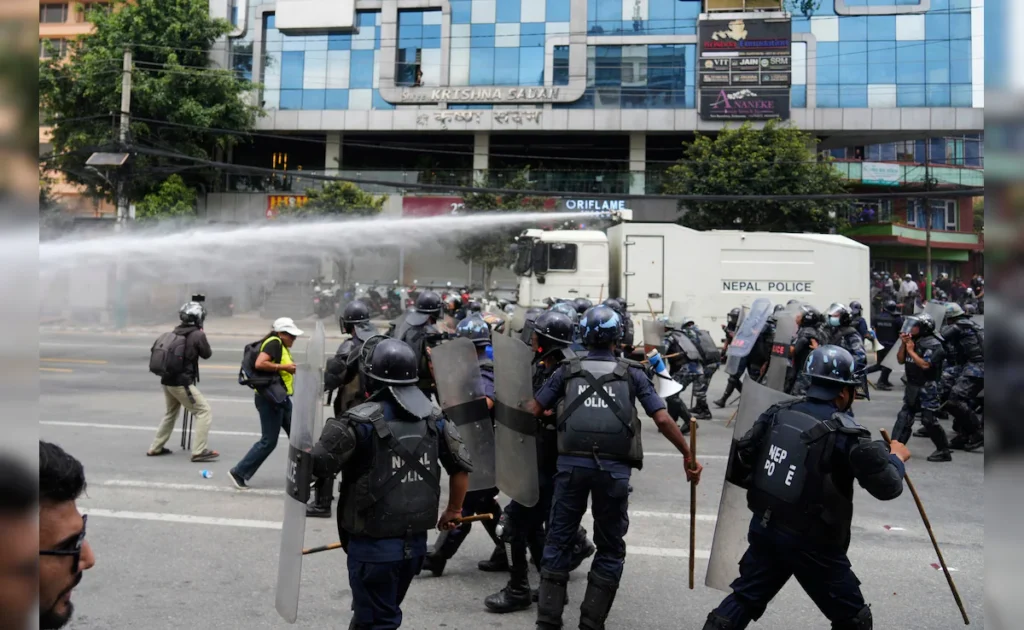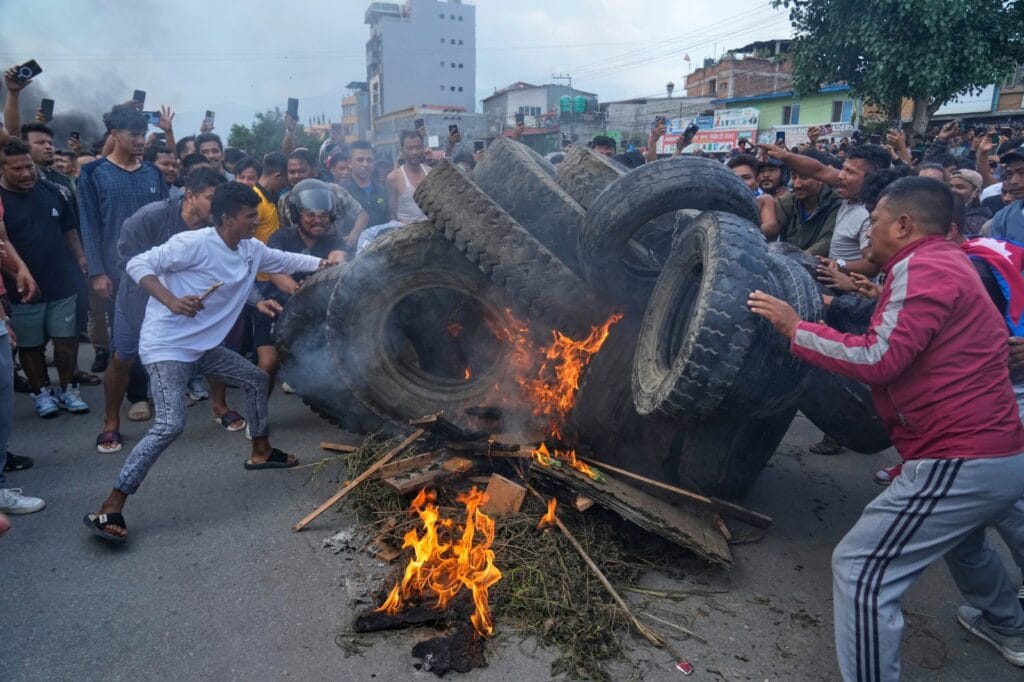Nepal: Nineteen fatalities and over 300 injuries resulted after thousands of Nepalese citizens young people took the streets to protest the KP Sharma Oli government decision to prohibit 26 social networking sites, such as Facebook, YouTube and X. The demonstrations in the capital Kathmandu spread to other places of Himalayan country. It had curfews in various places, such as Baneshwor, Singhadurbar, Narayanhiti and sensitive government zones.
The crackdown that the police had earlier in the day on the protesters was met with shots of rubber bullets and teargas shells. At this point a young protester asked the rest to move aside and asserted that they have been infiltrated by vested groups that are trying to provoke the crowd. The leader of the protest said: We have already won today. The Army was sent to the New Baneshwor region when the demonstrations were violent.
The Prime Minister Oli-led government announced that it has resolved to lift the ban as the protests spiral. Following a Nepalese cabinet meeting, Prithvi Subba Gurung, the Minister of Communication and Information Technology, stated that the government had instructed the agencies in question to commence the operation of reinstating the social media sites as per the requests of the so-called Gen Z, who organized a massive protest in front of the Parliament in the center of Kathmandu.
Here’s What Led To Protests

The Social Media Ban
Thursday, Nepal blocked social media platforms, such as Facebook and Instagram, because they have failed to get registered with the Ministry of Communication and Information Technology. Social media giants were given a week to be registered by the government, beginning August 28, said a notice. All of them had not submitted their applications before the deadline, including but not limited to Meta (Facebook, Instagram, WhatsApp), Alphabet (YouTube), X (previously Twitter), Reddit, and LinkedIn.
The government guidelines were based on a Supreme Court order in previous year. The social media giants had been requested to have a point of contact and nominate a resident grievance handling officer and compliance officer.
Tik Tok, Viber, Witk, Nimbuzz and Popo Live have been registered by the government, therefore, were not blocked. Telegram and Global Diary Applications are under review, it is being learnt.
What Do Protesters Say
According to a report in The Kathmandu Post, Facebook users in Nepal are approximated to be 13.5 million, and Instagram users are approximated to be 3.6 million. There are quite a good number whose business depends on social media. With the downing of the social media sites in Nepal, the affected began to protest. The protests against social media ban at that time snowballed into an anti-corruption protest.
The social media ban is what brought them here, but it is not the only reason why 24-year-old student Yujan Rajbhandari is standing here speaking to news agency AFP. We are agitating against corruption institutionalised in Nepal.
A 20 years old student, Ikshama Tumrok claimed she was protesting against the authoritarian attitude of the government. “We want to see change. This is something that has been experienced by others but it must stop with our generation, she said.
In a video doing rounds in the social media, one of the protestors can be heard saying, when the sons and daughters of the leaders have bright future where is ours?
What Has Government Said
On Sunday, the government announced in a statement that it values freedom of thought and expression and undertook to establish a conducive environment to protect and exercise the same freely.
In the past, the government has blocked access to Telegram on the grounds that the secure platform was being used to perpetrate online fraud and money laundering operations.
Nepal PM KP Oli Resigns Amid Deadly Gen Z Protests, Chaos On Streets

After two days of violent anti-corruption protests that took the lives of 21 people with about 100 more injured, Nepal Prime Minister KP Sharma Oli resigned Tuesday following such demonstrations organized by so-called Gen Z protesters. In the light of the negative state of affairs in the country, he resigned effective today in order to help solve the problem and assist in resolving the issue politically in line with the constitution to the president, Ram Chandra Paudel.
His aide Prakash Silwal confirmed with later confirmation that “The PM has quit. Images were of Mr Oli flying out of his office in a military helicopter. Soon the Chief Secretary of the Nepal government made an emotional appeal to calm. “… since the resignation of the Honourable PM is accepted, we are earnestly requesting all citizens to exercise restraint to further loss of life and property in this dire state of affairs…
Mr Paudel also resigned and this was after Mr Oli had resigned.
The question who replaces Mr Oli is one of the biggest now. Kathmandu Mayor Balendra Shah and parliamentarian Sumana Shrestha are also reportedly perceived to be candidates who have the favour of the protesters.
Today Mr Oli, 73, presided over a conference of all political parties, and was quoted to the effect that violence was not in the interest of the nation. We must make sure we engage in a peaceful dialogue in order to come up with solutions to this problem, he said.
One of the fundamental requirements of Gen Z protestors was the resignation of Mr Oli.
In Nepal, though, the resignation of the Prime Minister, however, does not necessarily imply that the government collapses. Mr Oli was the executive head and Mr Paudel the government head.
Report is that the Army will intervene until order is restored and a new government put in place.
That, in case true, will reflect unlucky happenings in Sri Lanka in 2022 and in Bangladesh in 2024. In both those situations anti-corruption demonstrations drove the governments of Mahinda Rajapaksa and Sheikh Hasina out of power,
And, again, in both instances the respective armies were brought out, or were brought in.

It is also speculated that the country would go back to a monarchy, a 239-year-old monarchy was abolished in May 2008, yet there has always been frequent demands to have the king back.
The resignation was confirmed hours after demonstrators stormed government offices – government buildings, including Parliament, the personal homes of Mr Oli and Mr Paudel and the buildings were gutted down.
Images revealed a war like scenario in Kathmandu capital, with small groups of young boys and girls in control of the streets and involving each other in full fledged fights with the police.
The smoke of acrid black plumed over the cityscape. Burning cars and trucks were scattered in the streets of the city. And demonstrators flooded the walls and gates of the domicile of Mr Oli and Mr Paudel.
The demonstrators also stormed into the Singha Durbar – the offices of different Nepalese ministries and government offices – by smashing its western gate, according to local media The Himalayan Times.
A protest, which started 36 hours ago after a ban on social media sites, such as Facebook, X, and YouTube, soon turned into a denunciation of the corruption in the Nepali government and denunciation of its inability to provide the economic development of the country.
For more updates follow: Latest News on NEWZZY
